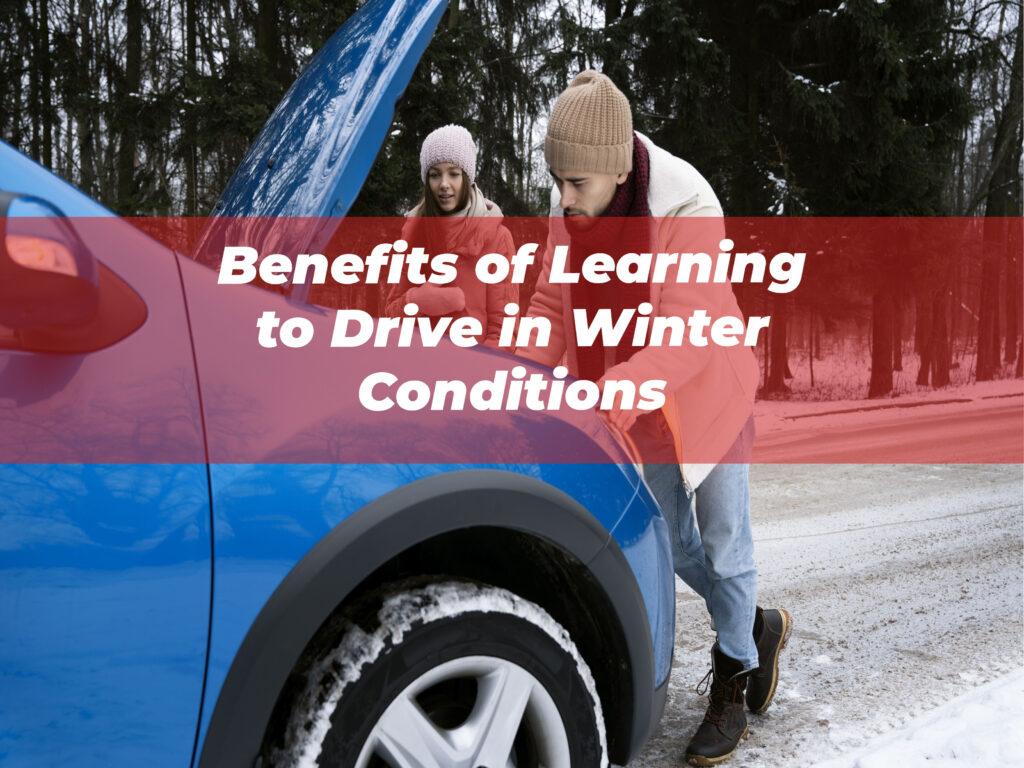Drive in Winter Conditions Conditions is a vital life skill that offers independence and freedom. While many people consider warm, dry weather the best time to get behind the wheel, there’s a powerful argument for learning to drive during winter conditions. Sure, icy roads, shorter days, and unpredictable weather might seem daunting, but they provide some of the most valuable and lasting lessons for new drivers.
Driving during the winter teaches skills and habits that no sunny summer day can replicate. Below, we’ll break down why winter is an excellent time to learn to drive and how this experience can shape you into a confident, capable driver ready to tackle any road conditions.
The Challenges of Drive in Winter Conditions
Winter driving conditions are tricky—for experienced and new Drive in Winter Conditions alike. Between snow, ice, rain, and reduced daylight, everything from handling a car to making safe decisions on the road requires extra caution and focus. These challenges might seem intimidating at first. However, learning in these conditions allows new drivers to tackle their fears early and build essential road skills from the outset.
What Makes Winter Driving Difficult?
- Reduced Traction: Snow, slush, and ice reduce a Drive in Winter Conditions grip on the road, greatly increasing stopping distance.
- Decreased Visibility: Fog, sleet, and early sunsets can make it difficult to see other vehicles, pedestrians, or road signs.
- Hazardous Conditions: Black ice, snowstorms, and sudden weather changes demand quick thinking and adaptability.
- Slower Reaction Times: Cold weather and fear of sliding can make new drivers hesitate longer before reacting.
When you’re faced with conditions like these right at the start of your driving experience, you’ll naturally develop skills and strategies that will serve you for life.
Why Learn to Drive in Winter?
Though the challenges of Drive in Winter Conditions are real, the rewards are just as significant. Here’s why learning during the colder months offers a unique set of advantages for new drivers.
1. Build Confidence in Difficult Situations
Winter driving demands focus and courage. By learning in icy or snowy conditions, you’ll build confidence much faster than if you only practiced on perfect sunny days.
Experiencing how to handle skids, brake on ice, and maintain control during a snowstorm doesn’t just make you more prepared for winter driving later in life. It also equips you with the mental strength to stay calm under pressure, regardless of the season.
2. Learn Advanced Driving Skills
The skills you develop in winter go beyond the basics of steering, Drive in Winter Conditions, and braking. You’ll learn techniques like controlling a skid, using your gears for descents, and safely maneuvering through snow-covered streets.
For example, winter teaches you how to predict and react to specific hazards, such as stopping well before intersections to mitigate ice or ensuring a safe following distance in poor conditions. These complex skills will become second nature as you gain more experience.
3. Develop Defensive Driving Habits
Drive in Winter Conditions conditions requires constant awareness of the road around you. This mindset naturally encourages defensive driving behaviors, like scanning for hazards, adapting your speed, and anticipating the actions of others. These habits are crucial year-round and result in a much safer driving approach overall.
4. Learn About Your Vehicle’s Behavior
Drive in Winter Conditions teaches you how a car behaves under different conditions. You’ll experience how four wheel-drive handles on snow, how anti-lock braking systems (ABS) function on icy roads, and how tire pressure changes in cold weather impact your vehicle’s grip. These insights are something many drivers only learn through experience, and learning early provides a massive advantage.
5. Tackle Fear Head-On
It’s natural to feel apprehensive about driving in adverse Drive in Winter Conditions, regardless of experience level. Learning to drive during winter helps you confront that fear and eliminate it early in your driving life. You’ll soon realize that, with proper techniques and attention, nearly any condition can be navigated safely.
Skills You’ll Develop Learning to Drive in Winter
1. Mastering Slippery Roads
Driving on icy or snowy roads requires good technique and precise control. Learning to brake gently, accelerate smoothly, and steer softly ensures your vehicle remains stable even in challenging conditions.
One crucial lesson is the importance of speed management. Drive in Winter Conditions too fast on slippery roads increases the chance of losing control, while driving too slowly may make certain maneuvers (like turning) harder. Winter practice teaches the perfect middle ground.
2. Braking Correctly
Effective braking on slippery surfaces is completely different from braking on dry roads. Through winter lessons, you’ll learn how to use anti-lock brakes effectively and understand why pumping the brakes (in non-ABS vehicles) is important for maintaining control.
For instance, when you feel your Drive in Winter Conditions, practising a gradual brake application is a skill every winter driver must know.
3. Adapting to Reduced Visibility
Freezing windscreens, fog, and early sunsets mean you’ll need to keep visibility in check. You’ll develop routines like clearing frost off your mirrors, using defoggers correctly, and adjusting headlight use to avoid dazzling others. Practising these habits as a learner instills them as second nature for the future.
4. Accurately Reading the Road
Drive in Winter Conditions a variety of road hazards that can be subtle and sudden. Black ice, for example, isn’t always visible, but you’ll learn to identify shaded areas where it’s most common or feel the tell-tale slickness when driving. Reading and adapting to road conditions helps you detect everything from hidden patches of snow to untreated gravel roads.
5. The Art of Patience
Winter driving forces you to slow down, assess situations carefully, and keep calm. Rushing only increases mistakes, and by practising patience, you become a responsible and composed driver.
Long-Term Benefits of Winter Driving Experience
Learning to drive in winter doesn’t just prepare you for the snowier months. It provides skills and habits that offer year-round advantages.
1. Higher Confidence in Any Weather
Snowstorms, heavy rains, or foggy mornings won’t faze you after learning to Drive in Winter Conditions. You’ll be more prepared to handle unexpected weather conditions because you’ve already faced the toughest.
2. Safer Driving Practices
Good habits, like maintaining greater braking distances and scanning for potential dangers, remain invaluable on dry roads as well. These skills make you a safer driver in all scenarios.
3. Prepared for Road Trips
Drive in Winter Conditions terrain is part of any long road trip. Whether tackling mountain passes in winter or gravel backroads in summer, the skills learned while driving in snow or ice translate perfectly to different road surfaces and conditions.
4. Adaptability in Emergencies
Being equipped to handle skids, spinning tires, or other vehicle issues increases your overall confidence during emergencies. You’ll apply these experiences to unforeseen situations, regardless of the season.
5. Impress Your Driving Examiner
While examiners don’t actively seek challenging conditions, showing calmness and control in snow or ice demonstrates your capabilities as a prepared and adaptable driver. This could give you an edge when earning your license.

Tips for Learning to Drive in Winter
1. Take Lessons with a Professional Instructor
Professional instructors are trained to help new Drive in Winter Conditions manage tough conditions safely. They’ll provide specific winter driving tips while ensuring you maintain control even in tricky scenarios like icy intersections or slushy turns.
2. Use a Dual-Controlled Vehicle
Most driving schools offer vehicles with dual-controls, meaning the instructor can take over if necessary. Dual controls offer peace of mind, allowing you to focus on confidence-building without fear of serious mistakes.
3. Understand Your Vehicle
Before driving, familiarize yourself with your Drive in Winter Conditions features. Learn how ABS, stability controls, and other safety systems work. Check your vehicle’s tires for adequate tread and ensure they’re appropriate for winter driving. If conditions are severe, consider practising with winter tires.
4. Start Slow
Choose less crowded roads or open spaces to gain initial confidence. Gradually introduce yourself to different challenges, from navigating busy streets to tackling winding country roads.
5. Dress Comfortably
Never underestimate the importance of comfort. Snow boots or too many layers can restrict your movement. Opt for comfortable shoes with good grip and layers that keep you warm while allowing full control.
6. Focus on Safety Tools
Always keep winter essentials handy, including an ice scraper, de-icer spray, and a basic emergency kit with blankets and flashlights. It’s good practice to prepare for surprises, such as sudden Drive in Winter Conditions trouble or extreme weather.
7. Stay Calm Under Pressure
It’s normal to feel nervous when driving in winter conditions. Slow down, breathe, and remember that careful techniques will help you maintain control. With time and practice, winter driving will become second nature.
Final Thoughts
Learning to drive in winter conditions may seem intimidating at first, but the benefits far outweigh the challenges. Winter driving shapes you into a confident, attentive, and skilled driver capable of handling any road conditions with ease. The specialized skills and defensive habits you gain will serve you for life, ensuring safer and better driving throughout the year.
Instead of waiting for spring, consider starting your driving lessons this winter. After navigating icy streets, snowy intersections, and stormy weather, you’ll emerge a well-rounded and fearless driver, ready for any season.










